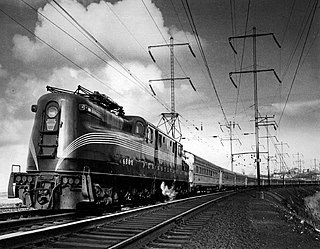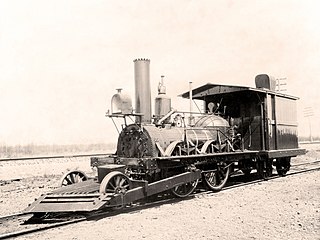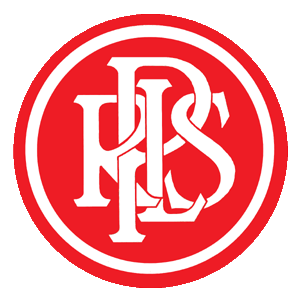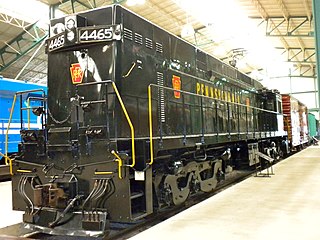The Pennsylvania Railroad, legal name The Pennsylvania Railroad Company, also known as the "Pennsy", was an American Class I railroad that was established in 1846 and headquartered in Philadelphia, Pennsylvania. At its peak in 1882, the Pennsylvania Railroad was the largest railroad, the largest transportation enterprise, and the largest corporation in the world.

The Northeast Corridor (NEC) is an electrified railroad line in the Northeast megalopolis of the United States. Owned primarily by Amtrak, it runs from Boston in the north to Washington, D.C. in the south, with major stops in Providence, New Haven, Stamford, New York City, Newark, Trenton, Philadelphia, Wilmington, and Baltimore. The NEC closely parallels Interstate 95 for most of its length. Carrying more than 2,200 trains a day, it is the busiest passenger rail line in the United States by ridership and service frequency.

Railway electrification is the use of electric power for the propulsion of rail transport. Electric railways use either electric locomotives, electric multiple units or both. Electricity is typically generated in large and relatively efficient generating stations, transmitted to the railway network and distributed to the trains. Some electric railways have their own dedicated generating stations and transmission lines, but most purchase power from an electric utility. The railway usually provides its own distribution lines, switches, and transformers.

The Pennsylvania Railroad GG1 is a class of streamlined electric locomotives built for the Pennsylvania Railroad (PRR), in the northeastern United States. The class was known for its striking art deco shell, its ability to pull trains at up to 100 mph, and its long operating career of almost 50 years.

John Bull is a historic British-built railroad steam locomotive that operated in the United States. It was operated for the first time on September 15, 1831, and became the oldest operable steam locomotive in the world when the Smithsonian Institution ran it under its own steam in 1981. Built by Robert Stephenson and Company, it was initially purchased by and operated for the Camden and Amboy Railroad, the first railroad in New Jersey, which gave it the number 1 and its first name, "Stevens". The C&A used it heavily from 1833 until 1866, when it was removed from active service and placed in storage.

Cab signaling is a railway safety system that communicates track status and condition information to the cab, crew compartment or driver's compartment of a locomotive, railcar or multiple unit. The information is continually updated giving an easy to read display to the train driver or engine driver.

The Pennsylvania-Reading Seashore Lines was a railroad that operated in South Jersey in the 20th century. It was created in 1933 as a joint consolidation venture between two competing railroads in the region: the Pennsylvania Railroad and the Reading Company.

Manhattan Transfer was a passenger transfer station in Harrison, New Jersey, east of Newark, 8.8 miles (14.2 km) west of New York Penn Station on the Pennsylvania Railroad (PRR) main line, now Amtrak's Northeast Corridor. It operated from 1910 to 1937 and consisted of two 1,100 feet (340 m) car-floor-level platforms, one on each side of the PRR line. It was also served by the Hudson and Manhattan Railroad. There were no pedestrian entrances or exits to the station, as its sole purpose was for passengers to change trains, or for trains to have their locomotives changed.

The SEPTA Regional Rail system is a commuter rail network owned by SEPTA and serving the Philadelphia metropolitan area. The system has 13 branches and more than 150 active stations in Philadelphia, Pennsylvania, its suburbs and satellite towns and cities. It is the sixth-busiest commuter railroad in the United States. In 2016, the Regional Rail system had an average of 132,000 daily riders and 118,800 daily riders as of 2019.

The Keystone Corridor is a 349-mile (562 km) railroad corridor between Philadelphia and Pittsburgh, Pennsylvania, that consists of two rail lines: Amtrak and SEPTA's Philadelphia-to-Harrisburg main line, which hosts SEPTA's Paoli/Thorndale Line commuter rail service, and Amtrak's Keystone Service and Pennsylvanian inter-city trains; and the Norfolk Southern Pittsburgh Line. The corridor was originally the Main Line of the Pennsylvania Railroad.

The PRR E44 was an electric, rectifier-equipped locomotive built by General Electric for the Pennsylvania Railroad between 1960 and 1963. The PRR used them for freight service on the Northeast Corridor. They continued in service under Penn Central and Conrail until Conrail abandoned its electric operations in the early 1980s. They were then acquired by Amtrak and NJ Transit, where they lived short lives; all were retired by the mid-1980s. One is preserved at the Railroad Museum of Pennsylvania.
Railroad electrification in the United States began at the turn of the 20th century and comprised many different systems in many different geographical areas, few of which were connected. Despite this situation, these systems shared a small number of common reasons for electrification.

Amtrak's 25 Hz traction power system is a traction power network for the southern portion of the Northeast Corridor (NEC), the Keystone Corridor, and several branch lines between New York City and Washington D.C. The system was constructed by the Pennsylvania Railroad between 1915 and 1938 before the North American power transmission grid was fully established. This is the reason the system uses 25 Hz, as opposed to 60 Hz, which is the standard frequency for power transmission in North America. The system is also known as the Southend Electrification, in contrast to Amtrak's 60 Hz traction power system that runs between Boston and New Haven, which is known as the Northend Electrification system.

The Pennsylvania Railroad's MP54 was a class of electric multiple unit railcars. The class was initially constructed as an unpowered, locomotive hauled coach for suburban operations, but were designed to be rebuilt into self-propelled units as electrification plans were realized. The first of these self-propelled cars were placed in service with the PRR subsidiary Long Island Rail Road with DC propulsion in 1908 and soon spread to the Philadelphia-based network of low frequency AC electrified suburban lines in 1915. Eventually the cars came to be used throughout the railroad's electrified network from Washington, D.C. to New York City and Harrisburg, Pennsylvania.

Pennsylvania Railroad 4876 was a GG1-class electric locomotive built in January 1939 at the PRR's Altoona Works in Altoona, Pennsylvania, United States. It is best known for being involved in an accident on January 15, 1953, when the locomotive overran a buffer stop, crashed into the concourse of Union Station in Washington, D.C., and fell partway into the basement after the train's brakes failed. Due to the major crowds expected for the upcoming inauguration of Dwight D. Eisenhower, 4876 was lowered the rest of the way into the basement and a temporary floor was erected overhead. After the inauguration, the locomotive's frame and superstructure was essentially scrapped on site, with all the reusable components shipped back to Altoona, Pennsylvania, to reconstruct a replacement 4876, which operated for another 30 years.

Pulse code cab signaling is a form of cab signaling technology developed in the United States by the Union Switch and Signal corporation for the Pennsylvania Railroad in the 1920s. The 4-aspect system widely adopted by the PRR and its successor railroads has become the dominant railroad cab signaling system in North America with versions of the technology also being adopted in Europe and rapid transit systems. In its home territory on former PRR successor Conrail owned lines and on railroads operating under the NORAC Rulebook it is known simply as Cab Signaling System or CSS.

The Budd Metroliner was a class of American electric multiple unit (EMU) railcar designed for first-class, high-speed service between New York City and Washington, D.C., on the Northeast Corridor. They were designed for operation up to 150 miles per hour (240 km/h): what would have been the first high speed rail service in the Western Hemisphere. Although 164 mph (264 km/h) was reached during test runs, track conditions and electrical issues limited top speeds to 120 mph (190 km/h) in revenue service. The single-ended units were designed to be arranged in two-car sets, which were in turn coupled into four to eight-car trains.

Amtrak’s 60 Hz traction power system operates along the Northeast Corridor between New Haven, Connecticut, and Boston, Massachusetts. This system was built by Amtrak in the late 1990s and supplies locomotives with power from an overhead catenary system at 25 kV alternating current with at 60 Hz, the standard frequency in North America. The system is also known as the Northend Electrification, in contrast to Amtrak's 25 Hz traction power system that runs between New York City and Washington, D.C., which is known as the Southend Electrification system.

The New York, New Haven and Hartford Railroad pioneered electrification of main line railroads using high-voltage, alternating current, single-phase overhead catenary. It electrified its mainline between Stamford, Connecticut, and Woodlawn, New York, in 1907 and extended the electrification to New Haven, Connecticut, in 1914. While single-phase AC railroad electrification has become commonplace, the New Haven's system was unprecedented at the time of construction. The significance of this electrification was recognized in 1982 by its designation as a Historic Mechanical Engineering Landmark by the American Society of Mechanical Engineers (ASME).

Ralston is an unincorporated community in McIntyre Township, Lycoming County, Pennsylvania, United States. The community is located along Pennsylvania Route 14, 18.5 miles (29.8 km) north of Williamsport. Ralston has a post office with ZIP code 17763.


















